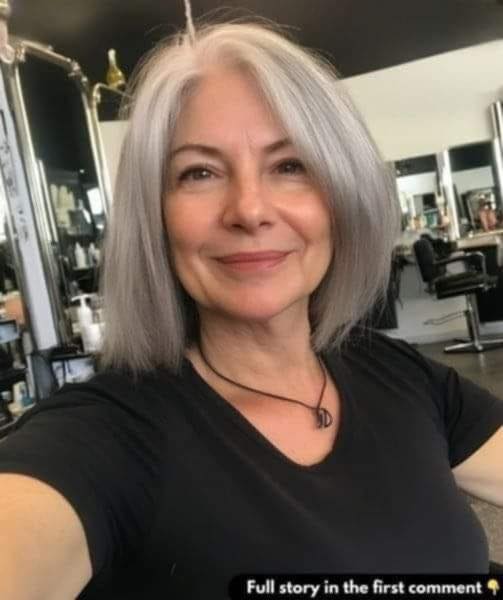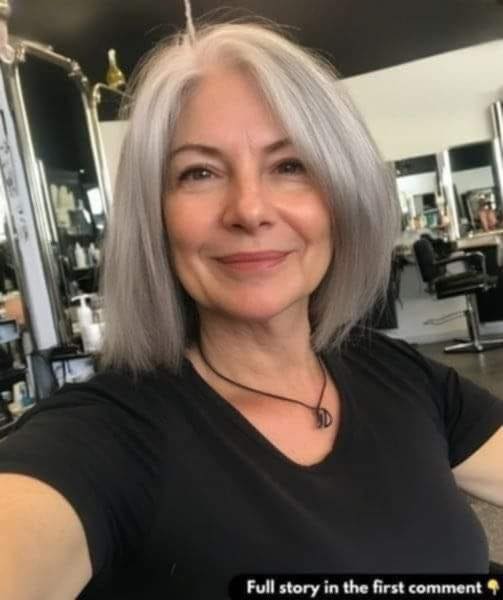So, my wife finally went to the hair salon today.
I was really hoping she’d get rid of that awful gray hair. Honestly, she looks like a mouse, and lately, I’ve been feeling a bit embarrassed when we’re out together.

She sent me a selfie from the salon, and guess what? Just a new haircut — but the gray hair is still there!
It looks terrible, and I have no idea how to tell her without causing a fight.
Should I just buy a box of hair dye and put it right under her nose so she gets the hint? I’m at a loss here. Help!
When I first wrote that message online, I didn’t think much of it. It was supposed to be a harmless vent. Just a frustrated husband sharing his thoughts.
But the internet had other plans.
Within hours, my post blew up. Thousands of comments poured in — and they weren’t what I expected.
“Disgusting? You mean natural?”
“Imagine your wife reading this. You don’t deserve her.”
“She’s embracing herself. Meanwhile, you’re stuck in vanity.”
I scrolled through the comments, my jaw tightening. People didn’t understand. I wasn’t trying to be cruel. I just missed how she used to look — the young, vibrant woman I fell in love with.
At least, that’s what I told myself.
But one comment stopped me cold.
It read:
“I’m a hairstylist. Women often keep their gray hair because they’re tired of hiding who they are. It takes courage to stop pretending. You might want to ask her why she chose to keep it… before you lose her completely.”
That one hit differently.
When my wife, Claire, came home that evening, she looked… different.
Not because of her hair — though it was cut beautifully, soft silver strands framing her face — but because of the way she carried herself.
Confident. Peaceful.
She kissed me on the cheek and smiled. “Well? What do you think?”
And there it was. The moment of truth.
Every instinct screamed at me to say something encouraging — but my pride got in the way.
“You didn’t… color it?” I asked carefully.
She shook her head. “No. I decided I’m done fighting who I am.”
“Oh,” I muttered, forcing a weak smile. “It’s… different.”
She raised an eyebrow. “Different bad or different good?”
I didn’t answer fast enough.
She just sighed. “Right. Different bad.”
Then she walked upstairs without another word.
That night, I couldn’t sleep.
I kept thinking about that comment online — the one that said she might be tired of pretending.
When had I become the kind of man who made his wife feel like she needed to hide her age?
I remembered when Claire first found her gray hairs — after our second child was born. She’d laughed about it back then, calling them her “silver trophies of survival.”
Somewhere along the way, I stopped laughing with her.
I started comparing her to other women — younger ones, flawless ones on social media who didn’t look tired, who didn’t have the same stretch marks, lines, or gray hair.
I realized with a sinking feeling that the problem wasn’t her.
It was me.
The next morning, Claire didn’t speak much. She made breakfast, packed the kids’ lunches, and went about her day like a ghost.
When she left for work, I sat at the kitchen table staring at her coffee cup — lipstick print still on the rim.
Guilt twisted inside me.
So I did something I never thought I’d do.
I booked an appointment — not for her, but for myself.
When I walked into the same salon she’d gone to, the stylist looked up in surprise.
“Hi, can I help you?” she asked.
“Yeah,” I said. “You did my wife’s hair yesterday. Claire.”
Her expression softened instantly. “Ah, yes. Beautiful woman. She said it was the first time in years she felt like herself again.”
Her words stung.
“I wanted to understand,” I said quietly. “Why she kept the gray.”
The stylist smiled kindly. “Because she finally gave herself permission. She said she was tired of being someone else’s version of ‘beautiful.’”
That night, when Claire came home, she looked surprised to see candles lit in the dining room.
I had dinner waiting. Nothing fancy — just her favorite: pasta and garlic bread.
She hesitated in the doorway. “What’s all this?”
“I owe you an apology,” I said, standing up. “For how I reacted. For how I’ve made you feel for years.”
Her eyes flickered with confusion — and maybe a little hope.
I took her hand. “When I met you, I fell in love with your laugh, your fire, your kindness. Somewhere along the line, I got scared of time — scared of change. I thought if I could keep you looking the same, nothing else would change either. But I was wrong. You’re more beautiful now than ever. Because you’re real. Because you’re you.”
Tears welled in her eyes.
“You really mean that?” she whispered.
I nodded. “Every word.”
She smiled then — the same smile I’d fallen for years ago, only wiser, softer, stronger.
A few weeks later, we went out for dinner together.
I noticed people glancing at her — not in the way I used to fear, but with admiration. Her silver hair caught the light beautifully, and she looked radiant.
When the waiter came, he smiled and said, “You two make a stunning couple.”
And for once, I believed it.
As we walked back to the car, she squeezed my hand. “You know,” she said teasingly, “I’ve been thinking about dyeing your hair gray so we match.”
I laughed. “I’d wear it proudly.”
Now, every time I see those silver strands glinting under the sun, I don’t see “old” anymore.
I see strength.
I see every sleepless night she endured with our kids, every moment she sacrificed her dreams for our family, every laugh line that marks a memory we built together.
Her gray hair isn’t something to be hidden.
It’s a crown — and I’m finally proud to walk beside my queen.
Moral:
Sometimes, the “flaws” we see in the people we love are only reflections of the insecurities we haven’t faced in ourselves.
And if we’re not careful, we might shame someone for simply having the courage to be real.


